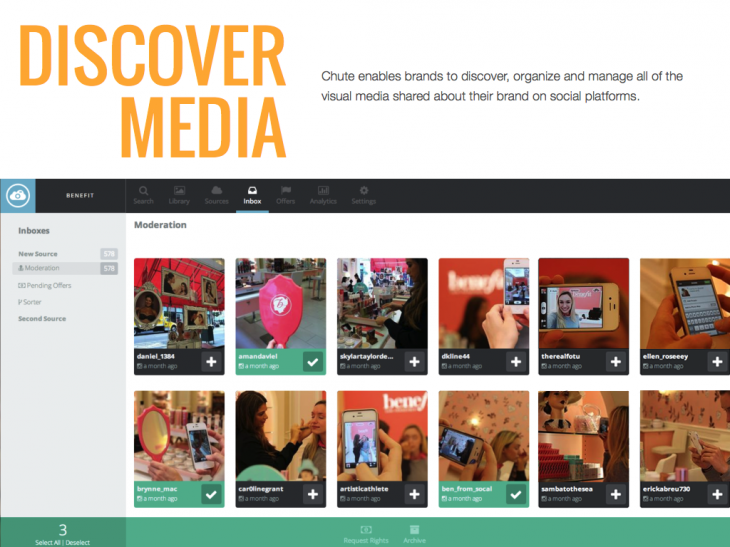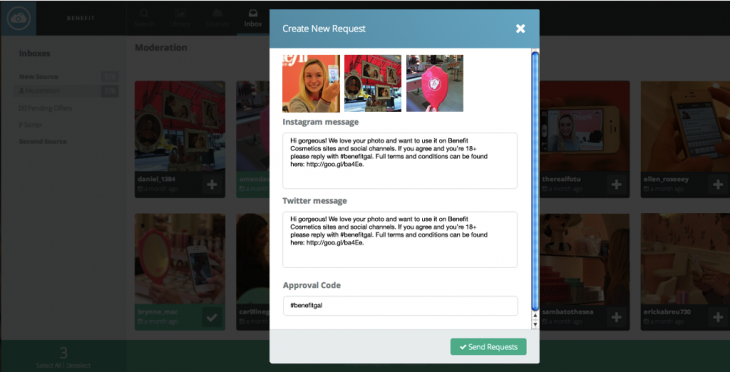
Media sharing company Chute is releasing a new solution designed to help brands and publishers better leverage user generated content within their campaigns. Called Chute Rights, it’s akin to a digital rights management solution through which brands can contact content creators on Instagram and Twitter to secure permission to use their images.
Company CEO and co-founder Ranvir Gujral says that, “with half a billion photos shared every day, consumers are telling incredibly compelling and visual stories about brands. Companies want to highlight theses stories, but until now, finding and clearing the rights to use consumer photos and videos was a tedious, manual process.”
The current marketplace is filled with tools and services that brands and publishers can use to curate media to help promote their goods and services. One need only look at what’s on the television at shows like American Idol, the Super Bowl, or anything else that encourages audience participation. Sure, they utilize hashtags to track conversations, but there are some occasions where people will snap photos having a good time, eating Doritos, or using a specific product — and brands know that consumers won’t be willingly sending it to them, but they will post it to Instagram, Twitter, and other forms of social media.
If you’re a brand or publisher running a marketing campaign and want to utilize consumer content, it’s always best to ask for permission first. There’s always Creative Commons, but finding the appropriate license can be rather difficult — it’s not visible to people unless you ask.
Some companies may have legal processes that require explicit permission. So if you happen to find photos on Twitter and Instagram around a particular hashtag or topic, using Chute Rights will help connect you to that content creator.
Understanding the four ways to get permission
We had a chance to speak with Chute’s other co-founder and Chief Product Officer Gregarious Narain, who explained that there are four ways that brands could typically gain permission to use a photo or video: hashtags, reply-based, link-based, and the direct method.
When it comes to hashtags, there are some brands who think that permission is granted when a creator “submits” a file by using the hashtag. By tagging your content, you could be giving brands the right to use that Instagram photo in their next marketing campaign.
As for reply-based, if a brand wants to use specific content, it can contact the user and only needs a reply to be granted permission. The next step in the permission chain is a link-based approach where instead of replying to inquiries, content creators will need to click on a link to complete a form. Lastly, the direct method approach involves filling out detailed forms and releases.
Chute Rights and the reply-based approach
Right now, Chute Rights is focusing on the reply-based approach. Brands can use the solution to locate images and then contact them to see if it can receive permission. Chute will leave a comment on that Instagram or Twitter post and if the creator agrees, they need only reply back with a specific code word (for example, a hashtag, number, keyword, etc.).
It’s important to note that Chute does not set up the legal process or the rights — it’s just a facilitator to help connect the creator with the brand. It’s with the different businesses to consult with legal counsel to understand how conservative or liberal they are with receiving permission.
Along with helping to request and secure rights, Chute Rights also provides a dashboard view of all those assets that brands have requested permission for. In a way, you could think about the company’s latest product as a media rights management solution, almost like what you might find on Getty Images or Shutterstock, but specifically relating to social media content.
But Chute Rights doesn’t have to pull from what content creators share on social media — it can accept files right from their hard drives. Utilizing the company’s Media Chooser feature, creators can upload media that brands may find interesting. From there, creators would need to grant permission through a license agreement or through a link-based approach.
Brands want to be creative, but how feasible is it?
So now that your brand has secured the rights to specific photos and videos, what do you do now? That’s entirely up to you — Chute is just the platform to help you better use the content. Naturally, the first thing that comes to mind would be to use it in social advertising, which the company supports through its banner ads that leverage real-time media.
Brands may want to use it on digital billboards, websites, publications, or other properties.
However, one thing that may concern some people is compensation for using their content in commercial situations. Will fans be willing to provide their content to brands just for a chance to see it somewhere online, in an ad, or anywhere else? And if the creator grants permission, is it royalty-free or will Chute Rights help brands manage payments?
When it comes to licensing, this may be on shaky grounds, because brands and publishers may come into the situation thinking that if it’s user-generated, then it’s free to use — but it isn’t. This is perhaps one of the reasons why Creative Commons was developed in the first place, but it’s only heavily promoted on Flickr. If you look at someone’s Instagram profile or see an image posted on Twitter, it lacks any credit or rights usage information. The question also could be raised about whether the content creator actually has the rights to the image or video?
More than just a photo wall
The release of Chute Rights is another way the company aims to become almost like Twilio, but for the media space. It’s creating tools and services that brands and publishers can utilize to help harness the so-called visual revolution in order to help tell a better story.
As opposed to services like Livefyre, which places a heavy emphasis on enabling customers to curate content, almost from a front-end standpoint with its acquisition of Storify, Chute is giving developers access to tools that they can use to craft their own tale — all without a specific framework: the company tells the story, not the infrastructure.
In the same way that Twilio aims to be for voice and messaging in the cloud, so too is Chute’s desire, but it’s certainly facing an uphill battle having to deal with the likes of Livefyre, Echo (which it has a joint app with), and Mass Relevance.
Photo credit: Thinkstock
Get the TNW newsletter
Get the most important tech news in your inbox each week.







